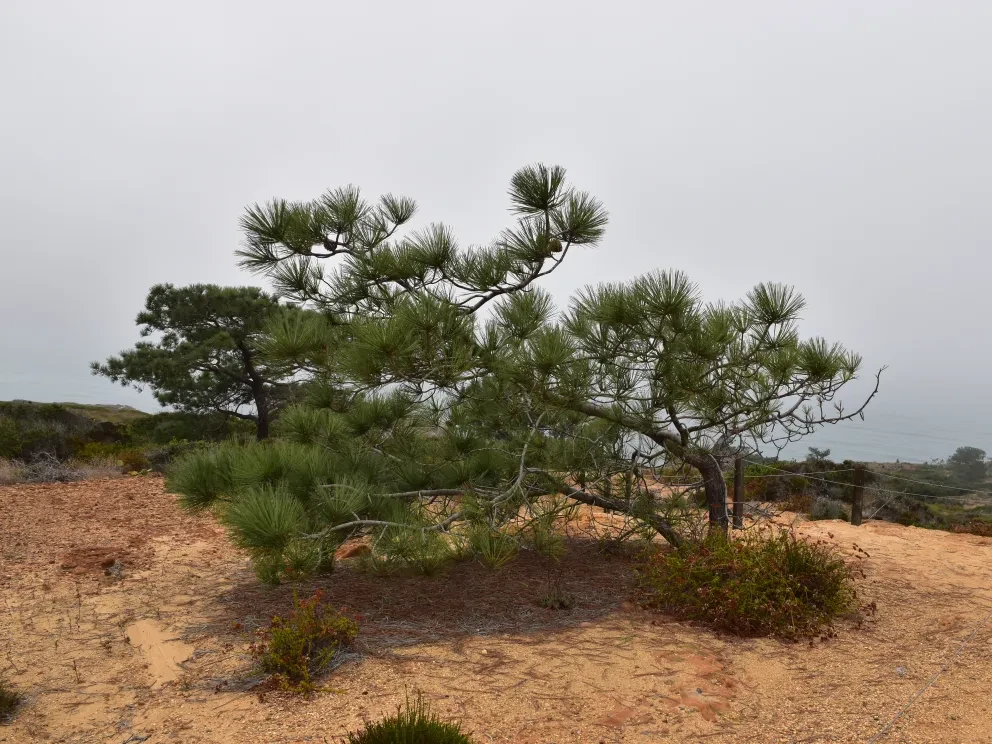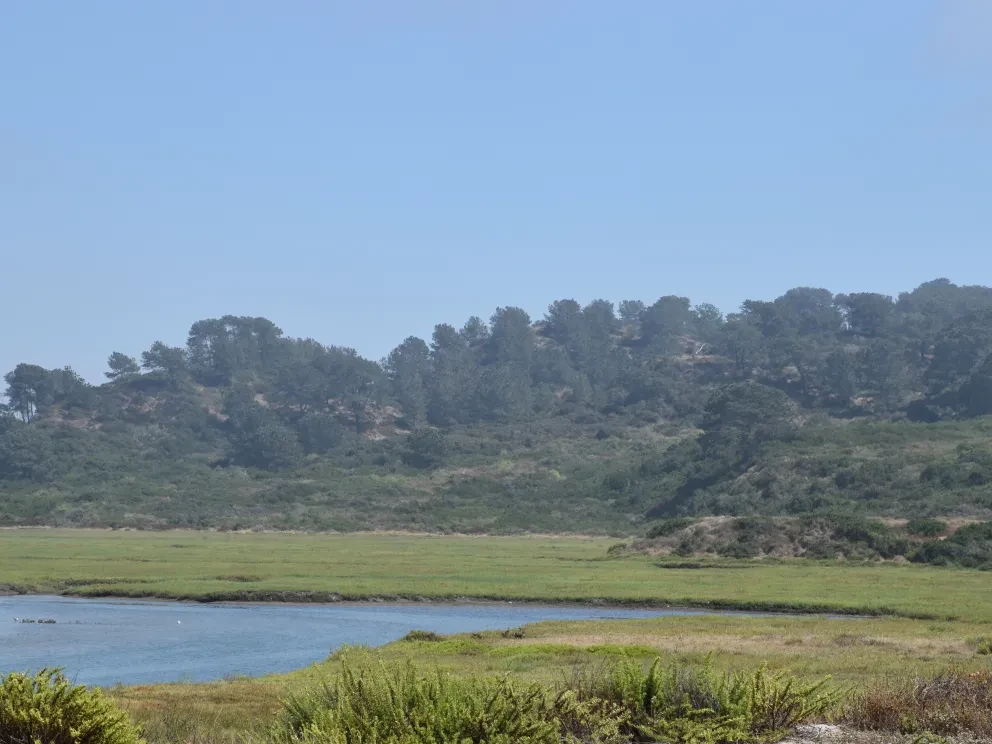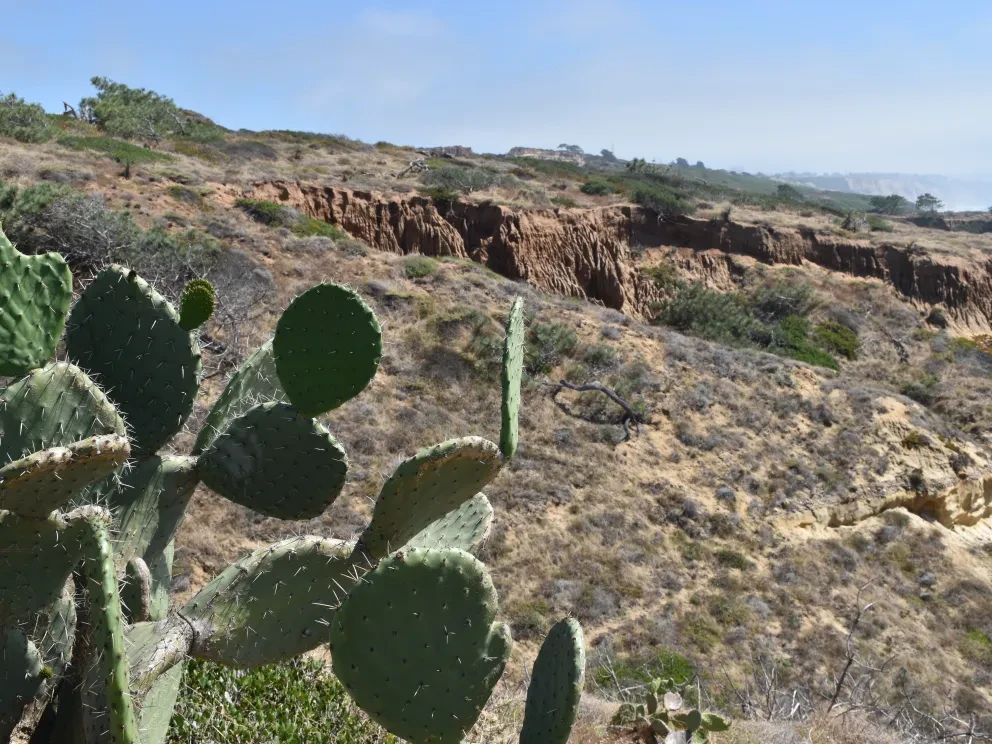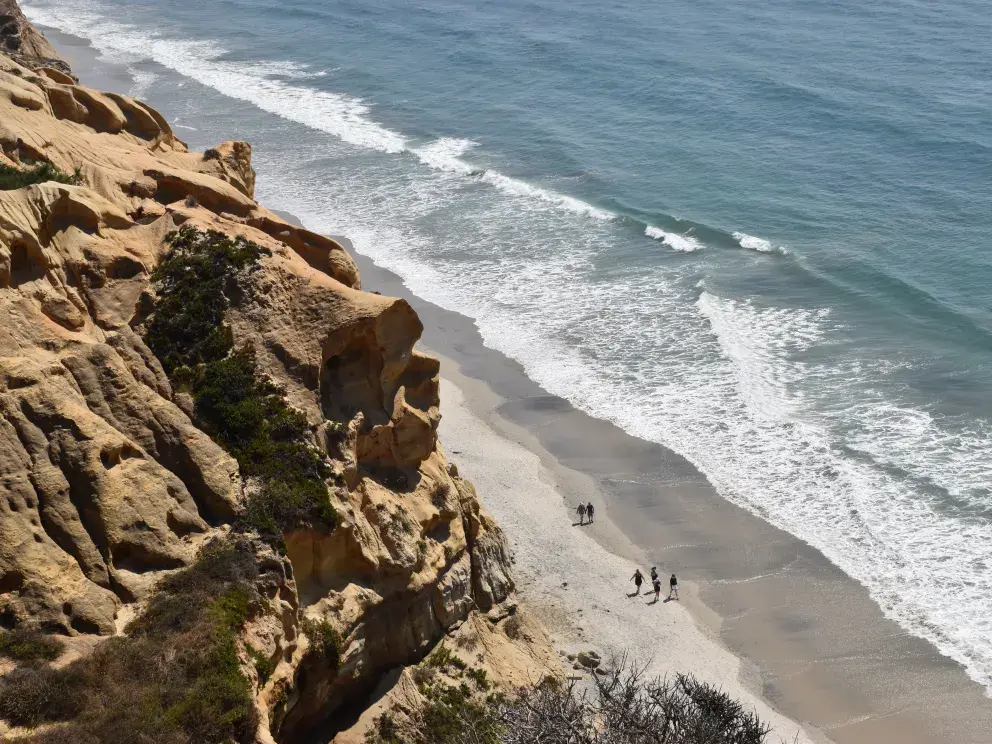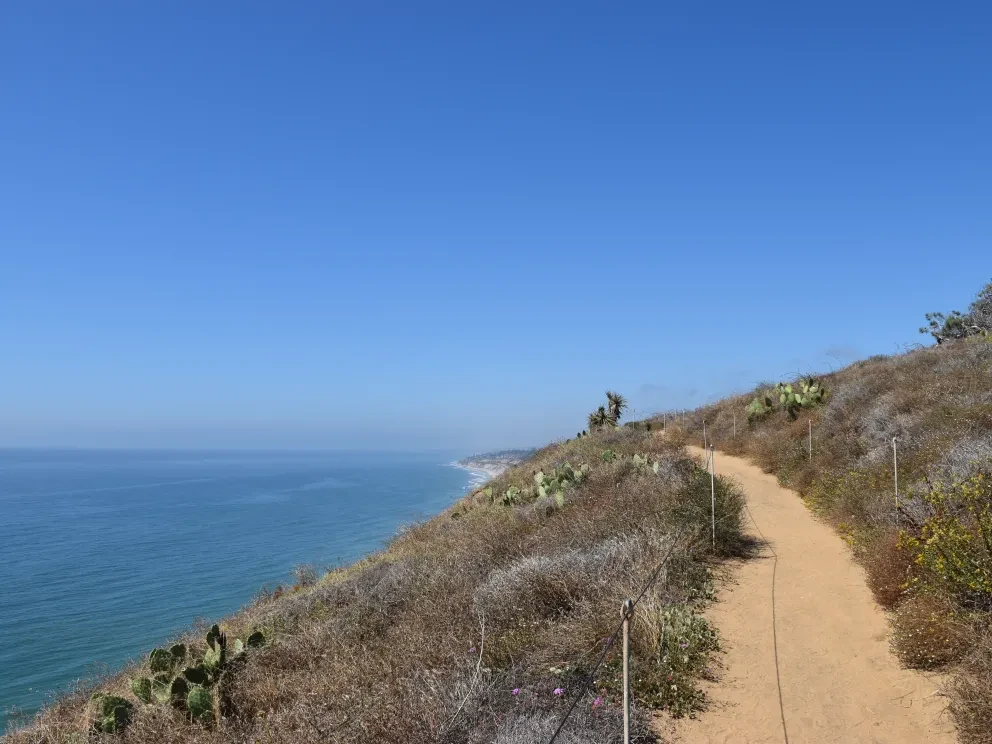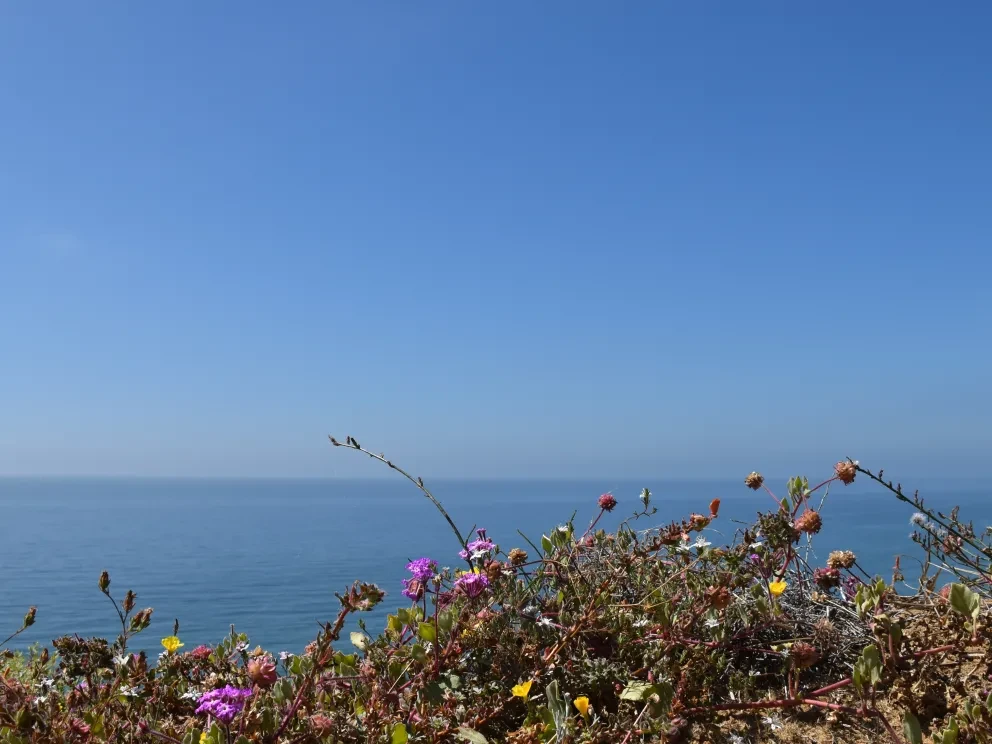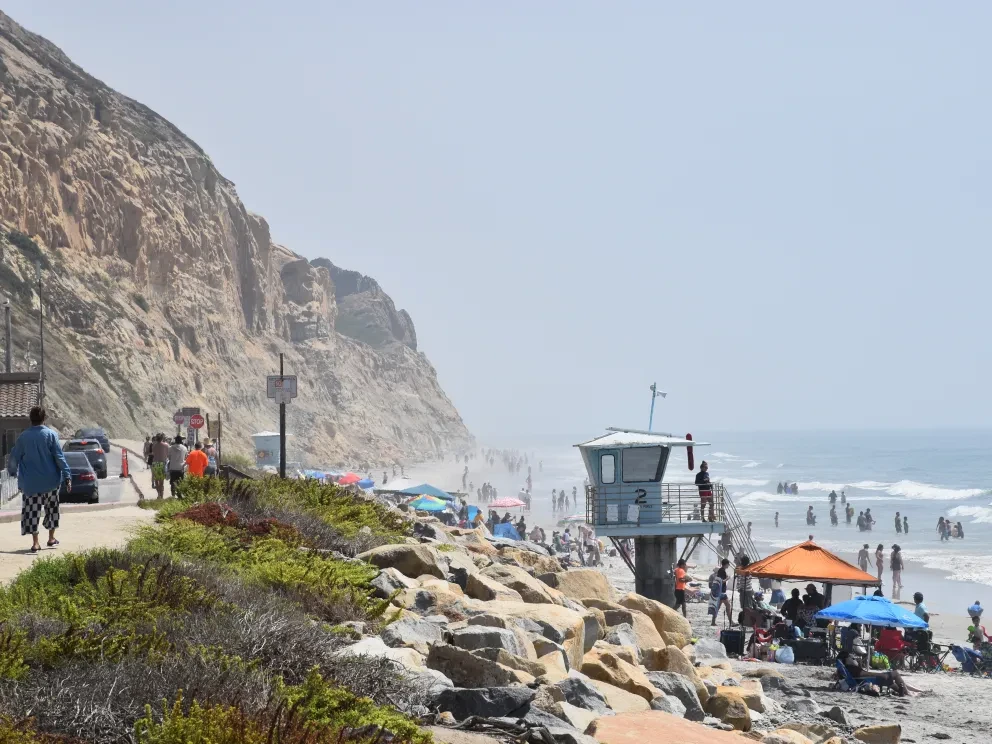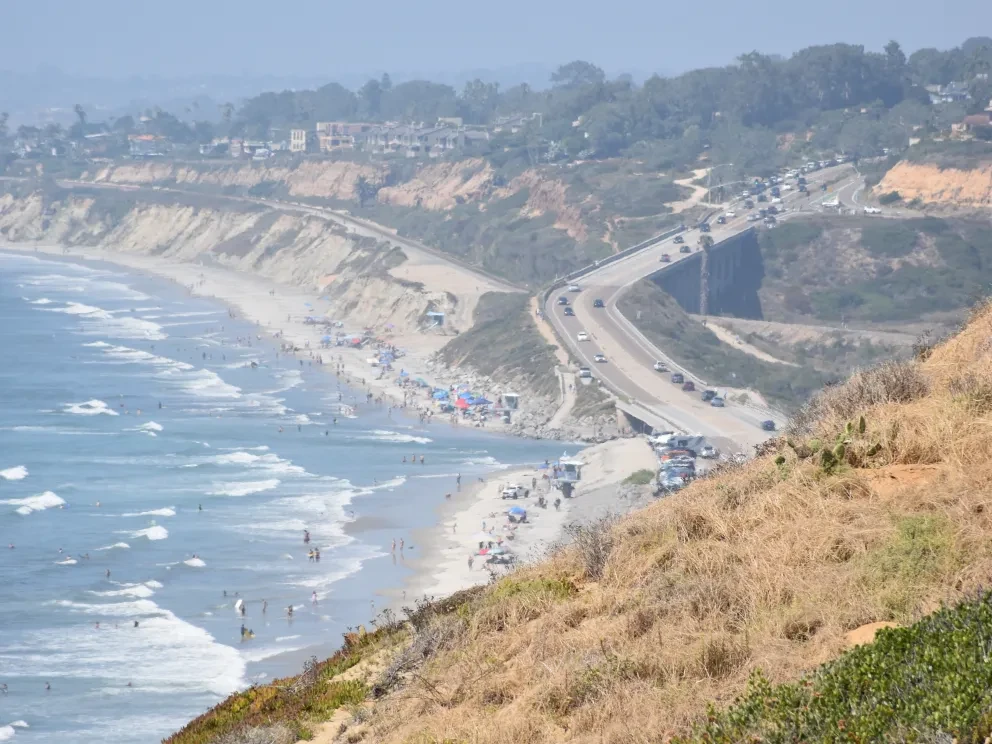By: Sue Mazingo
Torrey Pines State Natural Reserve is a must see in San Diego, a 2000-acre natural wilderness with breathtaking views of the Pacific, hiking trails through sculpted sandstone gorges, and access to the unspoiled beaches, tide pools, and one of the last remaining salt-marsh lagoons, vital to migratory seabirds.
The reserve is home to wildlife such as bobcats, foxes, skunks, raccoons, coyotes, and rabbits, and it boasts an abundant variety of wildflowers, ferns, cacti, and marine chaparral. But it is renowned for North America’s rarest pine tree: Pinus Torreyana, aka the Torrey pine.
The Torrey pine was once native to a large area of California. It now remains and is protected in just two areas separated by 175 miles of ocean: Torrey Pines State Reserve and Santa Rosa Island off the coast of Santa Barbara.
History
The reserve was established 1899 by the San Diego City Council on 364 acres of the ancestral homelands of the Kumeyaay people. A second ordinance expanded the reserve to 1,000 acres in 1924. Then in 1936, philanthropist Ellen Browning Scripps donated the North and Parry Groves. In 1959 the reserve became a state park. In 1970, 197 acres were added, and in 2007, the name was changed to Torrey Pines State Natural Reserve.
To this day, the reserve remains one of the wildest, and most popular, stretches of land on the Southern California coastline.
Things to see and do
There are many things to discover and do at the Torrey Pines Reserve, including hiking, exploring tide pools, whale watching, and geocaching.
Hiking
Though extraordinary, the trails at Torrey Pines Reserve are exposed with limited shade. Be sure to carry water and sunscreen on your hike. And don’t forget your camera! To keep the wilderness pristine, picnics are not allowed. During the summer months, beware of rattlesnakes.
As shown on the trail map, there are six hiking trails, showcasing broken cliffs, deep ravines, panoramic ocean views, and wind-swept pines.
-
Guy Fleming Trail – This is the first trail you will see when crossing the park’s entrance. It is a 0.6-mile loop with the greatest variety of plants and, in the spring, wildflowers. Elevation gain – 66 feet.
-
Parry Grove Trail – This trail is a 0.67-mile loop through Torrey pine trees with rugged and sometimes slippery stairs (over 100 steps). Elevation gain – 125 feet.
-
Beach Trail – Probably the most popular (and busiest), this 0.75-mile out-and-back trail provides access to the beach and tide pools but is a challenging descent (and return ascent) with a slippery spiral staircase at the bottom. When on the beach, be sure to stay at least 10 feet away from the cliffs. Rockslides and collapses are common and dangerous. Be aware of high tide, because strong surf can slam into the bluffs making the beach and tidepools inaccessible. Elevation gain – 331 feet.
-
Razor Point Trail – This trail leads to two overlooks, Razor Point and Yucca Point, where you can see patterns known as tafone sculpted in sandstone by erosion. From Razor to Yucca point, it is 0.4 miles. Along the way, you can climb Red Butte, a small rock formation with vistas of the area.
-
High Point Trail – This trail is only 100 yards with a short staircase. An out-and-back trail, it offers picturesque views of the reserve, lagoon, and inland. Elevation gain – 39 feet.
-
Broken Hill Trail – This trail is 1.33 miles via the South Fork and 1.25 miles via the North Fork down to the beach. This is the Reserve’s longest trail offering the most solitude. It joins Beach Trail just above Flat Rock. See Beach Trail for warnings. Elevation gain — 331 feet and 302 feet respectively.
Click here to see the full Torrey Pines Trail Guide and Map.
Tide pools
You can take Beach Trail or Broken Hill Trail down to the beach where you can visit tide pools atop Flat Rock or walk to Torrey Pines State Beach. Time your visit for low tide, because it becomes difficult to access and leave the beach as the tide rolls in, and during high tide, the area submerges in water. On the surface of Flat Rock, tiny pools are filled with salt-water organisms like sand crabs, barnacles, and sea anemone. Be prepared to get wet as waves crash over the pools.
Whale watching
From November to January, you can spot migrating gray whales from many of the vista points in the reserve. The Beach Trail and the Razor Point Trail are two of the best. This time of year, over 20,000 gray whales travel along the San Diego coastline southbound to Mexico. In mid-January, up to eight animals pass through every hour! From mid-June to September, you can spot blue whales and other types.
Geocaching
The reserve is also popular for geocaching, a treasure hunting game where participants use a GPS to hide and seek containers with other participants in the activity. Torrey Pines State Natural Reserve includes several caches such as Carmel Valley Fault, Advancing Shorelines, Marine Terraces, Penny Collector, and the Bells of El Camino Real. Visit geocaching.com to play.
Visitor Center and Museum Shop
Stop at the Visitor Center to learn about the park’s flora, fauna, and geology; view interpretive historical and natural exhibits; peruse the gift shop; or sign up for special programs or guided tours such as docent-led hikes and mindfulness walks. This pueblo-style building served as the Torrey Pines Lodge when it was built in 1923.
Side trips
-
Torrey Pines State Beach - On your way in or out of the reserve, be sure to stop at Torrey Pines State Beach to swim, surf, or walk. This beach is also a prime spot for surf fishing. During low tide, you can walk south to Flat Rock to explore the tide pools. To preserve wildlife, floating in the Los Peñasquitos Lagoon inlet below the Pacific Coast Highway bridge is prohibited.
-
Torrey Pines Extension – Torrey Pines Extension is located just across Los Peñasquitos Lagoon from the main reserve. It offers a variety of less-travelled and equally worthwhile trails. You can enter from Del Mar Scenic Parkway via Carmel Valley Road or from Mar Scenic Drive or Mira Montana Drive via Del Mar Heights Rd.
Getting There
Torrey Pines State Natural Reserve is located between Del Mar and La Jolla, just north of San Diego. Its official address is: 12600 N Torrey Pines Rd, La Jolla, CA 92037. From Hwy 5, exit Carmel Valley Road and drive west. After 1.5 miles, you’ll reach Coast Highway 101/North Torrey Pines Road. Turn left here and continue along the beach for about 1 mile. The park entrance is on the right-hand side.
To access the trails and visitor center, you can park at the top of the hill or park at the bottom and hike up the steep one-mile entrance road. There is free parking located along Coast Highway 101/North Torrey Pines Road, right before the entrance, but it is very difficult to find a space. Note: Recreational vehicles longer than a standard parking spot are allowed only in the North Beach lot off of Carmel Valley Road.
Hours and Fees
Park hours are 7:15 am to sunset with the Visitor Center open daily from 9:00 am to 5 pm. The busiest hours are from 10 am to 1 pm. The General Admission Day Use fee is $10-$25 per vehicle (demand base pricing) or $195 for the “California Explorer” Annual Day Use Pass which covers most parks and Southern California beaches in the state park system. You can purchase both passes at the park kiosk. See parks.ca.gov for information on all the passes available.
Be sure to check out the new innovative access programs for children and families to explore California’s state park system. The California State Park Adventure Pass, this gives fourth graders and their families who live in the state a free pass to access 19 selected state parks for a full year. The State Library Parks Pass, provides free vehicle day-use entry to over 200 participating state park units operated by State Parks to library-card holders. The Golden Bear Pass, makes it easier for families who receive CalWORKs, individuals who receive supplemental security income, and income-eligible Californians over the age of 62 to receive a free annual, vehicle day-use pass valid at 200+ state parks.
Rules
To ensure future generations have access to this protected habitat, camping, food, alcohol, drones, smoking, open flames, loud music, and dogs are not permitted at Torrey Pines State Natural Reserve. Torrey Pines is a fragile ecosystem and has a high fire danger. Please stay on the trails and do not pick/collect natural features such as pinecones or flowers and leave no trace.
More info
For more information on the reserve, visit the Torrey Pines State Natural Reserve website.
